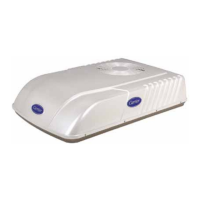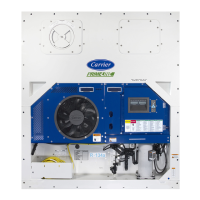T--298
1-11
COMPRESSOR
ACCUMULATOR
REVERSING VALVE
INDOOR COIL
OUTDOOR COIL
STRAINER
CAPILLAR Y
TUBE
DISCHARGE
SUCTION
LIQUID
Figure 1 -10 Refrigerant Flow Schematic -- Heat Pump -- (Heat Mode)
1.7.2 Heating
The heating cycle is energized when the thermostat,
located in the ceiling unit, calls for heat The system
controls are positioned for “reverse” refrigerant flow,
with the compressor discharge delivered to the indoor
coil and liquid delivered to the outdoor coil. (See
Figure 1-10.)
The main components of the system are the
compressor, reversing valve, indoor coil, capillary tube,
strainer, air-cooled outdoor coil, and the accumulator.
The compressor raises the pressure and the
temperature of the refrigerant and forces it through the
discharge line and reversing valve into the indoor coil.
The indoor blower (fan) pulls inside air through the
filters, which remove particulate matter, and then pass
the cleaned air through the indoor coil.
Thevehicleair(whichisatatemperaturelower thanthe
refrigerant) passes over the outside of the coil tubes.
Heat transfer is established from the refrigerant (inside
thetubes)tothevehicle air(flowingoverthetubes).The
tubes have fins designed toimprovethetransfer of heat
from the refrigerant gas to the air; this removal of heat
causes the refrigerant to liquefy, thus liquid refrigerant
leaves the coil and flows through the strainer to the
outdoor coil. Thestrainerremovesany impurities within
the refrigerant system.
The capillary tubemeters theflow of liquid refrigerant to
the outdoor coil. As the refrigerant flows through the
capillary tube, there is a reduction in pressure and
temperature.
The low pressure, lowtemperature liquidthat flows into
the outdoor coil tubes is colder than the outdoor air that
is circulated over thetubes. Heat transfer isestablished
from the outdoor air (flowing over the tubes) to the
refrigerant (flowing inside the tubes). The outdoor coil
tubes havealuminum finstoincreaseheattransferfrom
the air to the refrigerant.
The transfer of heat from the air to the low temperature
liquid refrigerant in the outdoor coil causes the liquid to
vaporize. This low temperature, low pressure vapor
passes into the accumulator. The accumulator is
designed with the inlet tube delivering refrigerant to the
bottom of the tank and the outlet tube taking refrigerant
formthe top of the tank. This arrangement ensures that
only vapor refrigerant is returned to the compressor,
where the cycle repeats.
When ventilation only is selected, the indoor fan
functions to circulate air throughout the vehicle. The
refrigerant cycle will remain off.

